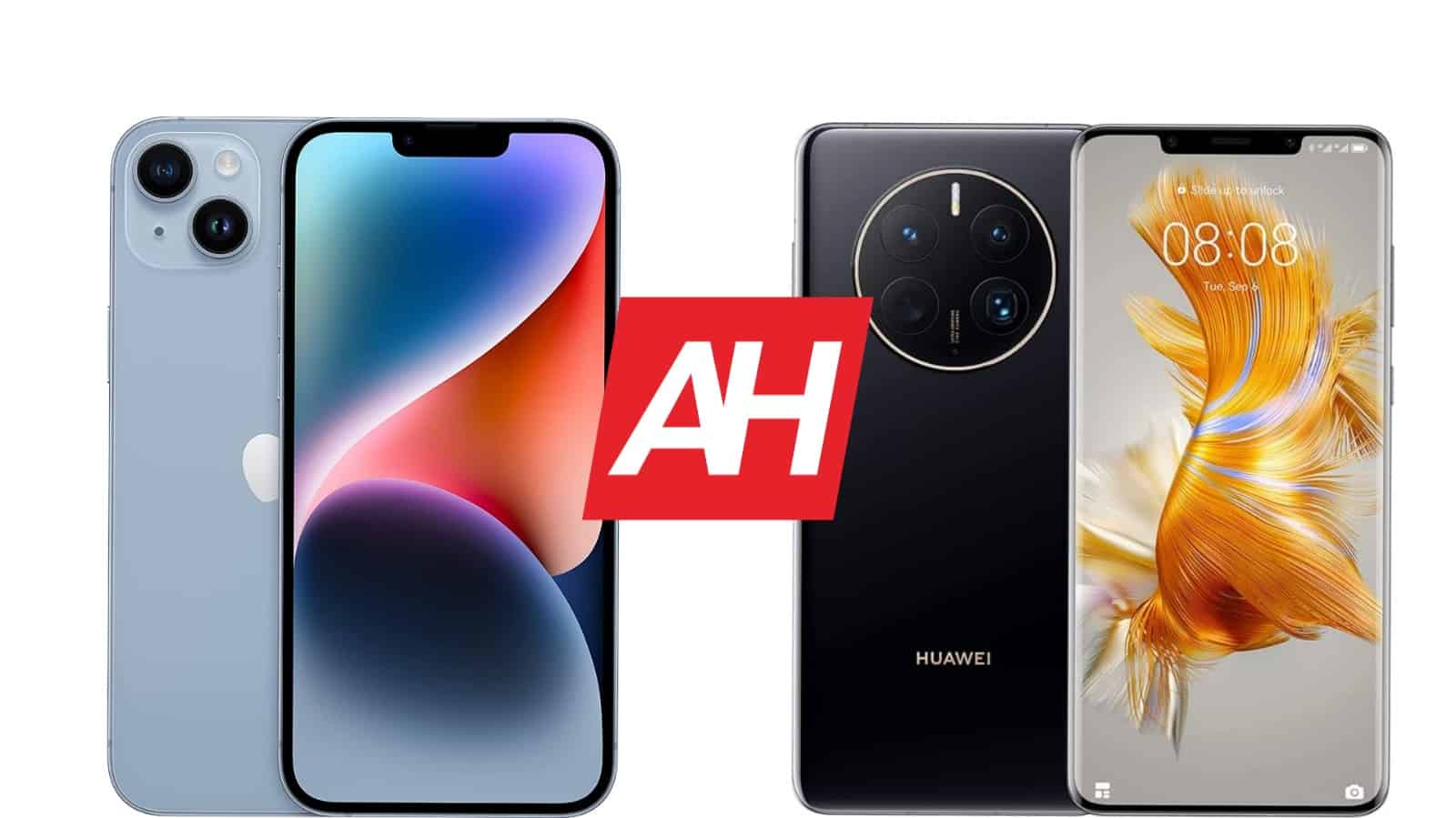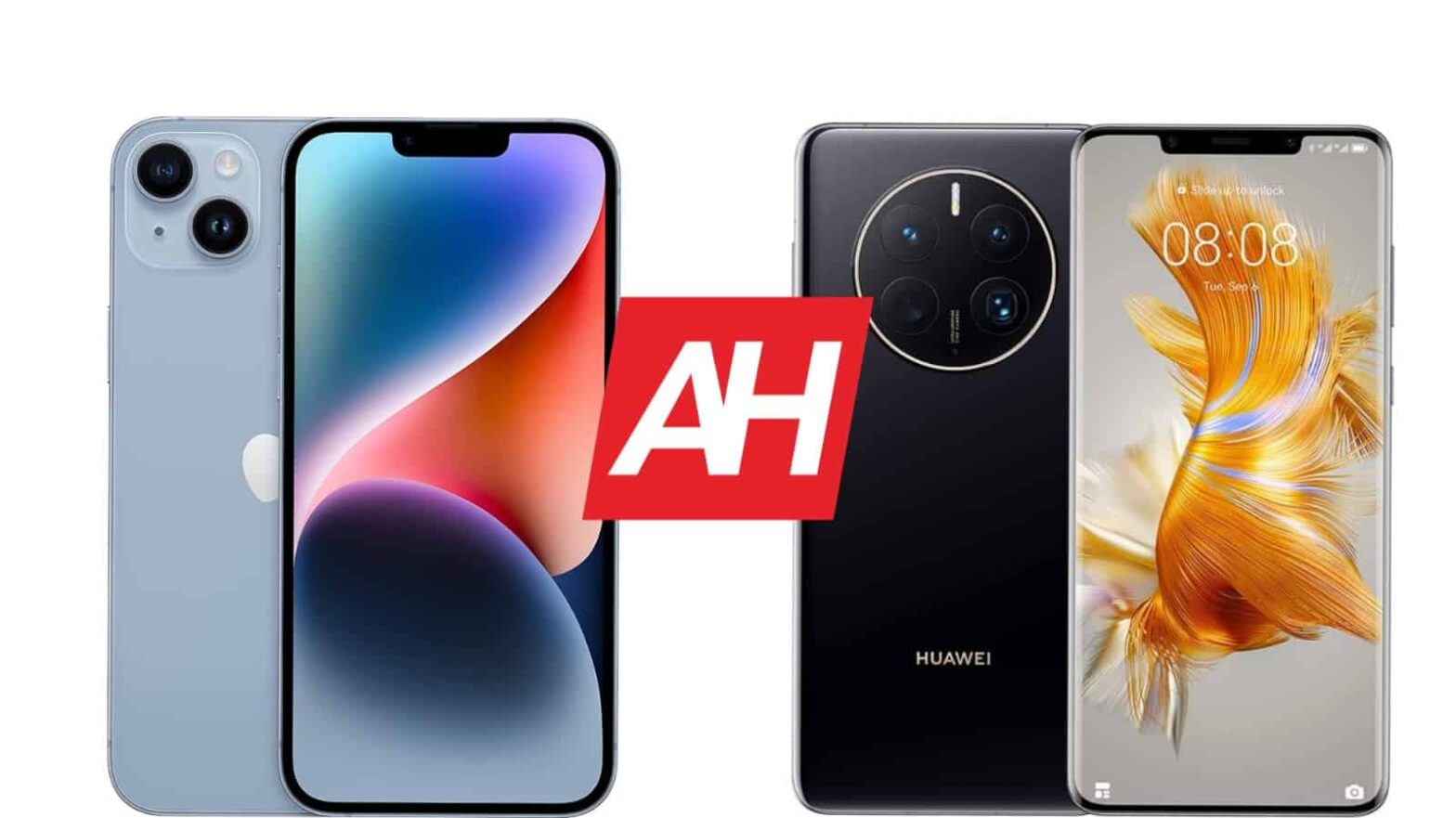In this article, we’ll compare the Apple iPhone 14 Plus vs Huawei Mate 50 Pro. We’ve already compared the iPhone 14 Pro Max with Huawei’s best offering at the moment, and it’s time to see how the ‘Plus’ model compares. Both of these smartphones are quite large, so if you’re into more compact devices, these two probably won’t interest you. Both of these phones are quite compelling, but they are notably different.
We’ll first list out their specifications, and will then move to a number of other categories. We’ll compare their designs, displays, performance, battery life, cameras, and audio performance, as per usual. Before we get started, however, do note that the Mate 50 Pro does not ship with Google services, so you won’t get access to the Google Play Store or Google’s apps. Huawei’s AppGallery is pre-installed, though, while there are very useful third-party stores at your disposal, such as Aurora Store. That being said, let’s get started.
Specs
Apple iPhone 14 Plus
Huawei Mate 50 Pro
Screen size
6.7-inch Super Retina XDR OLED display (60Hz refresh rate)
6.74-inch QHD+ curved OLED display (120Hz refresh rate)
Screen resolution
2778 x 1284
2616 x 1212
SoC
Apple A15 Bionic
Qualcomm Snapdragon 8+ Gen 1
RAM
6GB
8GB (LPDDR5)
Storage
128GB, 256GB, 512GB, non-expandable (NVMe)
256GB/512GB, expandable (UFS 3.1)
Rear cameras
12MP (wide, f/1.5 aperture, 26mm lens, 1.9um pixel size, dual pixel PDAF, sensor-shift OIS)
12MP (ultrawide, f/2.4 aperture, 13mm, 120-degree FoV)
50MP (f/1.4-f/4.0, 24mm lens, wide angle, OIS, PDAF, Laser Autofocus)
13MP (f/2.2 aperture, 13mm lens, 120-degree FoV, ultrawide, PDAF)
64MP (f/3.5 aperture, 90mm lens, OIS, PDAF, 3.5x optical zoom)
Front cameras
12MP (wide-angle, f/1.9 aperture, 23mm lens, PDAF)
SL 3D (depth/biometrics sensor)
13MP (ultrawide, f/2.4 aperture, 18mm lens)
ToF 3D (depth/biometrics)
Battery
4,323mAh, non-removable, 23W wired charging, 15W MagSafe wireless charging, 7.5W Qi wireless charging
Charger not included
4,700mAh, non-removable, 66W wired charging, 50W wireless charging, 5W reverse wireless charging
Charger included
Dimensions
160.8 x 78.1 x 7.8mm
162.1 x 75.5 x 8.5mm
Weight
203 grams
205 grams (vegan leather)/209 (glass) grams.
Connectivity
5G, LTE, NFC, Bluetooth 5.3, Wi-Fi, Lightning port
4G LTE, NFC, Bluetooth 5.2, Wi-Fi, USB Type-C
Security
Advanced facial scanning
In-display fingerprint scanner (optical)
OS
iOS 16
Android 12
EMUI 13
Price
$899
€1,299
Buy
Apple
Huawei
Apple iPhone 14 Plus vs Huawei Mate 50 Pro: Design
As mentioned earlier, both of these phones are quite large, mainly due to their large displays. The iPhone 14 Plus is a bit shorter, and wider, while it’s also thinner. It weighs a couple of grams less than the Mate 50 Pro, and that’s not something you’ll notice. Both phones have a frame made out of aluminum, while they also come with glass backs. The Mate 50 Pro is available in a variant with a vegan leather backplate too, by the way. That’s the variant we tested, actually.
The weight distribution is good on both phones, but the Mate 50 Pro was more pleasant to hold and use. It doesn’t have sharp edges like the iPhone 14 Plus, as it doesn’t have flat sides. It’s way curvier than the iPhone 14 Plus, partially due to its curved display. Both phones have extremely thin bezels, and display notches. Both of them also come with advanced facial scanning. The Mate 50 Pro’s notch is wider and shorter.
The iPhone 14 Plus has two cameras on the back, which are a part of the camera island in the top-left corner. The Huawei Mate 50 Pro has a much more pronounced camera island, which is centered at the top of the phone’s back. It includes three cameras, and it’s circular. The vegan leather Mate 50 Pro that we’ve used is a lot easier to use with one hand, as it’s considerably less slippery. Both phones do feel like quality products in the hand.
Apple iPhone 14 Plus vs Huawei Mate 50 Pro: Display
The iPhone 14 Plus features a 6.7-inch 2778 x 1284 Super Retina XDR OLED display, it’s a 60Hz panel. That panel is flat, and it does support HDR10 content. It also has Dolby Vision support, while it gets up to 1,200 nits of brightness at its peak. We’re looking at a 19.5:9 aspect ratio here, while the panel is protected by the Ceramic Shield Glass. The iPhone 14 Plus has a screen-to-body ratio of 87.4%, approximately.
The Huawei Mate 50 Pro, on the other hand, includes a 6.74-inch 2616 x 1212 OLED display. This panel is curved, and it has a 120Hz refresh rate, though it’s not an LTPO panel. The Mate 50 Pro display has the same aspect ratio as the iPhone 14 Plus, while it’s protected by the Huawei Kunlun Glass. The Mate 50 Pro has a 91.3% screen-to-body ratio, approximately.
On paper, the Huawei Mate 50 Pro has a more advanced display. The sheer fact it has a 120Hz refresh rate, compared to a 60Hz one on the iPhone 14 Plus, is a major advantage. In almost all other aspects, the two displays are comparable. They both look really good, they’re vivid, and the viewing angles are also good. The blacks are deep, and the touch response is also quite good. We basically have no complaints in terms of image reproduction on either display, they’re both well tuned.
Apple iPhone 14 Plus vs Huawei Mate 50 Pro: Performance
The iPhone 14 Plus is fueled by the Apple A15 Bionic SoC. That is the same chip that fueled the entire iPhone 13 series, and it’s very much still amongst the best processors in the market. The phone also utilizes 6GB of RAM and NVMe storage. The Huawei Mate 50 Pro comes with the Snapdragon 8+ Gen 1 SoC, along with 8GB of LPDDR5 RAM and UFS 3.1 flash storage. Do note that this is a 4G only version of the chip, though, in the Mate 50 Pro’s case.
Does this translate to good performance? Well, yes, and not only good, but great, in both cases. They’re both well-equipped, hardware-wise, but they’re also well tuned. These two phones are buttery smooth in every way, pretty much. Ranging from multitasking and browsing to consuming multimedia and gaming. It doesn’t really matter. They do get warm during longer gaming sessions, but we did not notice any performance drop offs or anything of the sort. Chances are that both phones will keep on performing great for quite some time.
Apple iPhone 14 Plus vs Huawei Mate 50 Pro: Battery
The iPhone 14 Plus includes a 4,323mAh unit, while the Huawei Mate 50 Pro has a 4,700mAh battery. As we always say, iPhones need smaller battery packs than Android phones, so this difference doesn’t really mean anything. The iPhone 14 Plus actually offers outstanding battery life, and it does trump the Mate 50 Pro in that category, despite the fact the Mate 50 Pro has a really good battery life.
Getting 8-9 hours of screen-on-time from the iPhone 14 Plus is a real possibility. If you’re gaming, you probably won’t go as high, but if you’re not, it’s not a problem to go there. The Mate 50 Pro is closer to 7-7.5 hours of screen-on-time, but I managed to push it to 8 hours on several occasions. Both of these phones do offer excellent battery life, so that’s not something you should worry about. Your results may be different than this, though, depending on your usage and some other factors.
When it comes to charging, the Mate 50 Pro blows the iPhone 14 Plus out of the water. The iPhone 14 Plus supports 20W wired, 15W MagSafe wireless, and 7.5W Qi wireless charging. The Mate 50 Pro has support for 66W wired, 50W wireless, and 5W reverse wireless charging. Do note that the iPhone 14 Plus doesn’t include a charger in the box, while the Mate 50 Pro does, and one that will take full advantage of that charging speed.
Apple iPhone 14 Plus vs Huawei Mate 50 Pro: Cameras
The iPhone 14 Plus includes two cameras on the back, while the Mate 50 Pro has three. 12-megapixel wide-angle and 12-megapixel ultrawide angle shooters are included in Apple’s product. The Mate 50 Pro has a 50-megapixel main camera, a 13-megapixel ultrawide unit, and a 64-megapixel periscope telephoto camera. Now, these two camera setups both perform great, but offer considerably different results.
The iPhone 14 Plus essentially has the same camera setup as the iPhone 13 Pro series (safe for the telephoto unit, of course). In other words, it’s really good. These cameras are extremely reliable, but not perfect. They tend to struggle with oversharpening at times, with foliage, for example. You can also end up with overblown highlights at times. The vast majority of images look outstanding, though. The Mate 50 Pro, on the other hand, does an excellent job across the board. It very rarely doesn’t provide the picture you’re looking for. It’s extremely reliable, and it provides warm, detailed pictures, it also does a great job in HDR conditions and in low light. Its variable aperture is obviously doing the trick in addition to everything else.
Both ultrawide cameras are excellent, while the Mate 50 Pro does a better job with telephoto shots, simply because of the fact it has a telephoto camera. In fact, it does an excellent job with zoomed-in shots. Its 3.5x optical zoom definitely helps, but the Mate 50 Pro can zoom in truly far away scenes with ease. The further you get, the worse the image gets, of course, but that’s the case with every periscope telephoto shot, of course.
The video recording is excellent on both phones, but the iPhone 14 Plus has an edge there. It does a great job in almost every scene when it comes to video. I’d personally choose the Mate 50 Pro for pictures, and the iPhone 14 Plus for video, if that helps.
Audio
Both of these phones include a pair of stereo speakers. Both sets are good, but the Huawei Mate 50 Pro does have an edge in this regard. The sound coming from its speakers is a bit clearer, and the speakers themselves do get a bit louder
You will not find an audio jack on either phone. If you want to achieve a wired audio connection, you’ll need to use the Lightning and Type-C ports on the iPhone 14 Plus and Huawei Mate 50 Pro, respectively. Bluetooth 5.3 (iPhone) and 5.2 (Huawei) are included on the two phones as well, for wireless connections.
The post Phone Comparisons: Apple iPhone 14 Plus vs Huawei Mate 50 Pro appeared first on Android Headlines.

Source: ndroidheadlines.com
